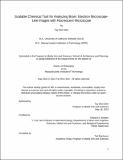Scalable Chemical Tool for Analyzing Brain: Electron Microscope-Like Images with Fluorescent Microscope
Author(s)
Shin, Tay Won
DownloadThesis PDF (3.369Mb)
Advisor
Boyden, Edward S.
Terms of use
Metadata
Show full item recordAbstract
Neuroscientists have long studied complex neural circuits by examining their ultrastructure and molecular features. Electron microscopy (EM) has greatly advanced our fundamental understanding of neurobiology by revealing ultrastructural features through dense labeling of membranous structures while fluorescence microscopy (FM) allowed neuroscientists to identify and study specific biomolecules of interest. However, it would be ideal if such imaging could be achieved with FM (i.e., conventional light microscope), allowing anyone to identify and localize biomolecules in the detailed ultrastructural context of neural circuits. In this study, we report a novel membrane probe and modified expansion microscopy (ExM) protocol aimed at achieving conventional light microscope images that are comparable to low-resolution EM, enabling the visualization of ultrastructural features in thick mice brain tissue sections with molecular contrast, and pointing the way towards the possibility of tracing and reconstructing the neural circuitries. We demonstrate the ability of this novel strategy, which we call ultrastructure membrane expansion microscopy (umExM), to show ultrastructural features that were previously observable with EM using light microscopy and the localization of biomolecules in the ultrastructural context with a resolution of ~60 nm. Combining umExM with existing fluorescence fluctuation imaging methods (i.e., SRRF), we achieved a resolution of ~30 nm. umExM may enable the routine use of ultrastructure imaging in neurobiology.
Date issued
2023-06Department
Program in Media Arts and Sciences (Massachusetts Institute of Technology)Publisher
Massachusetts Institute of Technology